Distinct compartmentalization of NF-κB activity in crypt and crypt-denuded lamina propria precedes and accompanies hyperplasia and/or colitis following bacterial infection
- PMID: 22144489
- PMCID: PMC3264290
- DOI: 10.1128/IAI.06101-11
Distinct compartmentalization of NF-κB activity in crypt and crypt-denuded lamina propria precedes and accompanies hyperplasia and/or colitis following bacterial infection
Abstract
Citrobacter rodentium induces transmissible murine colonic hyperplasia (TMCH) and variable degrees of inflammation and necrosis depending upon the genetic background. Utilizing C. rodentium-induced TMCH in C3H/HeNHsd inbred mice, we observed significant crypt hyperplasia on days 3 and 7 preceding active colitis. NF-κB activity in the crypt-denuded lamina propria (CLP) increased within 24 h postinfection, followed by its activation in the crypts at day 3, which peaked by day 7. Increases in interleukin-α1 (IL-1α), IL-12(p40), and macrophage inflammatory protein 1α (MIP-1α) paralleled NF-κB activation, while increases in IL-1α/β, IL-6/IL-12(p40)/granulocyte colony-stimulating factor (G-CSF)/keratinocyte-derived chemokine (KC)/monocyte chemotactic protein 1 (MCP-1), and MIP-1α followed NF-κB activation leading to significant recruitment of neutrophils to the colonic mucosa and increased colonic myeloperoxidase (MPO) activity. Phosphorylation of the crypt cellular and nuclear p65 subunit at serines 276 and 536 led to functional NF-κB activation that facilitated expression of its downstream target, CXCL-1/KC, during TMCH. Distinct compartmentalization of phosphorylated extracellular signal-regulated kinase 1 and 2 ([ERK1/2] Thr(180)/Tyr(182)) and p38 (Thr(202)/Tyr(204)) in the CLP preceded increases in the crypts. Inhibition of ERK1/2 and p38 suppressed NF-κB activity in both crypts and the CLP. Dietary administration of 6% pectin or 4% curcumin in C. rodentium-infected mice also inhibited NF-κB activity and blocked CD3, F4/80, IL-1α/β, G-CSF/MCP-1/KC, and MPO activity in the CLP while not affecting NF-κB activity in the crypts. Thus, distinct compartmentalization of NF-κB activity in the crypts and the CLP regulates crypt hyperplasia and/or colitis, and dietary intervention may be a novel strategy to modulate NF-κB-dependent protective immunity to facilitate crypt regeneration following C. rodentium-induced pathogenesis.
Figures
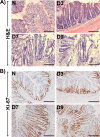
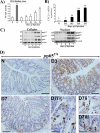

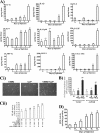
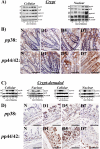
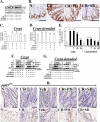


Similar articles
-
Evidence of functional cross talk between the Notch and NF-κB pathways in nonneoplastic hyperproliferating colonic epithelium.Am J Physiol Gastrointest Liver Physiol. 2013 Feb 15;304(4):G356-70. doi: 10.1152/ajpgi.00372.2012. Epub 2012 Nov 29. Am J Physiol Gastrointest Liver Physiol. 2013. PMID: 23203159 Free PMC article.
-
Novel changes in NF-{kappa}B activity during progression and regression phases of hyperplasia: role of MEK, ERK, and p38.J Biol Chem. 2010 Oct 22;285(43):33485-33498. doi: 10.1074/jbc.M110.129353. Epub 2010 Aug 14. J Biol Chem. 2010. PMID: 20710027 Free PMC article.
-
Citrobacter rodentium-induced NF-kappaB activation in hyperproliferating colonic epithelia: role of p65 (Ser536) phosphorylation.Br J Pharmacol. 2006 Jul;148(6):814-24. doi: 10.1038/sj.bjp.0706784. Epub 2006 Jun 5. Br J Pharmacol. 2006. PMID: 16751795 Free PMC article.
-
Critical roles of Notch and Wnt/β-catenin pathways in the regulation of hyperplasia and/or colitis in response to bacterial infection.Infect Immun. 2012 Sep;80(9):3107-21. doi: 10.1128/IAI.00236-12. Epub 2012 Jun 18. Infect Immun. 2012. PMID: 22710872 Free PMC article.
-
Effects of hypoxic exposure on immune responses of intestinal mucosa to Citrobacter colitis in mice.Biomed Pharmacother. 2020 Sep;129:110477. doi: 10.1016/j.biopha.2020.110477. Epub 2020 Jul 6. Biomed Pharmacother. 2020. PMID: 32768962
Cited by
-
Differential effects of β-catenin and NF-κB interplay in the regulation of cell proliferation, inflammation and tumorigenesis in response to bacterial infection.PLoS One. 2013 Nov 21;8(11):e79432. doi: 10.1371/journal.pone.0079432. eCollection 2013. PLoS One. 2013. PMID: 24278135 Free PMC article.
-
Intestinal tuft cells regulate the ATM mediated DNA Damage response via Dclk1 dependent mechanism for crypt restitution following radiation injury.Sci Rep. 2016 Nov 23;6:37667. doi: 10.1038/srep37667. Sci Rep. 2016. PMID: 27876863 Free PMC article.
-
Compartment specific responses to contractility in the small intestinal epithelium.PLoS Genet. 2024 Mar 22;20(3):e1010899. doi: 10.1371/journal.pgen.1010899. eCollection 2024 Mar. PLoS Genet. 2024. PMID: 38517900 Free PMC article.
-
Mice Deficient in Epithelial or Myeloid Cell Iκκβ Have Distinct Colonic Microbiomes and Increased Resistance to Citrobacter rodentium Infection.Front Immunol. 2019 Sep 10;10:2062. doi: 10.3389/fimmu.2019.02062. eCollection 2019. Front Immunol. 2019. PMID: 31552024 Free PMC article.
-
Tis7 deletion reduces survival and induces intestinal anastomotic inflammation and obstruction in high-fat diet-fed mice with short bowel syndrome.Am J Physiol Gastrointest Liver Physiol. 2014 Sep 15;307(6):G642-54. doi: 10.1152/ajpgi.00374.2013. Epub 2014 Jul 24. Am J Physiol Gastrointest Liver Physiol. 2014. PMID: 25059825 Free PMC article.
References
-
- Barthold SW, Osbaldiston GW, Jonas AM. 1977. Dietary, bacterial, and host genetic interactions in the pathogenesis of transmissible murine colonic hyperplasia. Lab. Anim. Sci. 27:938–945 - PubMed
-
- Bhattacharyya S., et al. 2007. Tumor-induced oxidative stress perturbs nuclear factor-kappaB activity-augmenting tumor necrosis factor-alpha-mediated T-cell death: protection by curcumin. Cancer Res. 67:362–370 - PubMed
-
- Bohuslav J, Chen LF, Kwon H, Mu Y, Greene WC. 2004. p53 induces NF-κB activation by an IκB kinase-independent mechanism involving phosphorylation of p65 by ribosomal S6 kinase 1. J. Biol. Chem. 279:26115–26125 - PubMed
Publication types
MeSH terms
Substances
Grants and funding
LinkOut - more resources
Full Text Sources
Research Materials
Miscellaneous

